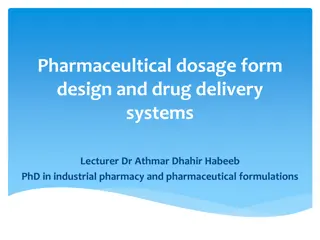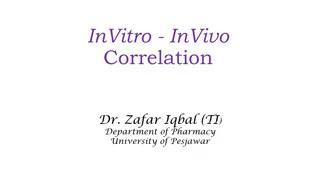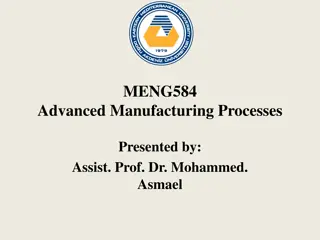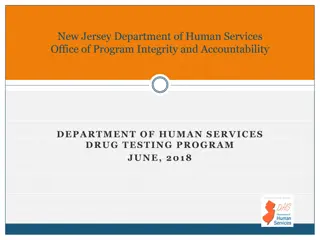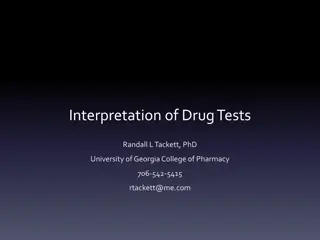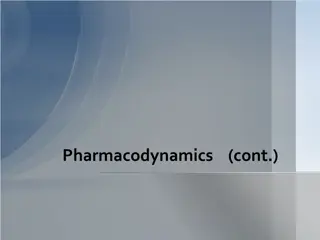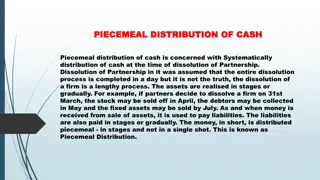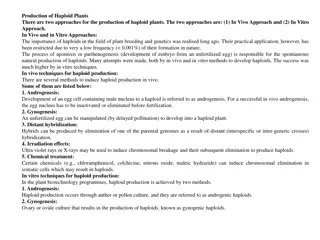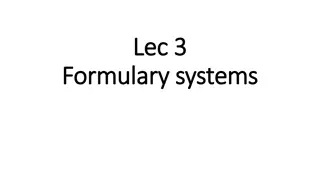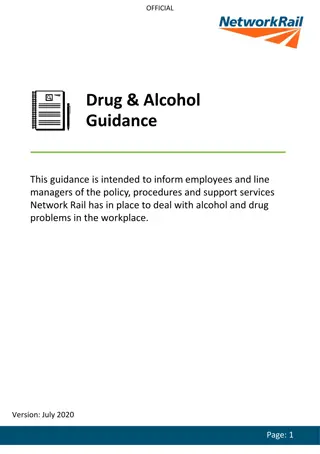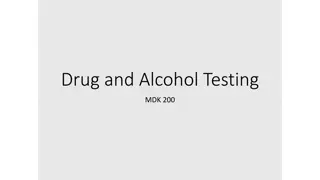Importance of In-Vitro Dissolution Testing in Drug Assessment
In drug development, in-vitro dissolution testing plays a crucial role in evaluating drug release from tablets when in-vivo bioavailability studies are limited. By ensuring drug release is close to 100% and uniform batch to batch, these tests help assess drug availability and effectiveness. Regulatory standards like USP/NF monographs specify test conditions such as medium, apparatus, time limits, and RPM. Different methods like basket and peddle type are used for conducting dissolution tests. Test tolerance, expressed as a percentage of the labeled drug amount dissolved within a specified time, is another key aspect of in-vitro dissolution studies.
Download Presentation

Please find below an Image/Link to download the presentation.
The content on the website is provided AS IS for your information and personal use only. It may not be sold, licensed, or shared on other websites without obtaining consent from the author. Download presentation by click this link. If you encounter any issues during the download, it is possible that the publisher has removed the file from their server.
E N D
Presentation Transcript
Dissolution test (official test) Lab 6 1
8/5/2024 Dissolution test Dissolution Test For complete assessment of a drug release from tablets(in-vivo bioavailability should be accomplished) but its use is restricted, thus in-vitro dissolution test have been used and developed and it is un-direct measurement of drug availability.
12 8/5/2024 Why In-vitro dissolution studies? 1. To show that the release of the drug from the tablet is as close to 100%. 2. To show that the rate of drug release is uniform batch to batch. to show that equivalent to those batches proven to be bioavailable and clinically effective. 3. And the release is
4 8/5/2024 USP/NF monograph specify: The dissolution test medium Apparatus to be used Time limits of the test The assay procedure Volume (dissolution medium) The speed (rpm) of the test to be performed
5 8/5/2024 Dissolution test Types of dissolution tests used: 1. Basket method (apparatus I ) A single tablet is placed in a small wire mesh basket attached to the bottom of the shaft connected to a variable speed motor. The basket is immersed in a dissolution medium (as specified in monograph) contained in a 1000 ml flask. The flask is cylindrical with a hemispherical bottom. The flask is maintained at 37 0.50C by a constant temperature bath. The motor is adjusted to turn at the specified speed and sample of the fluid are withdrawn at intervals to determine the amount of drug in solutions.
6 8/5/2024 Click to View Image Notes: The most common rotation speed for basket method is 100 rpm. It preferred capsules dosage forms that tend to float or disintegrate slowly. is generally for and
7 8/5/2024 2. Peddle type (apparatus 2) The rotating speed is 50 rpm. most common It is generally preferred for tablets. It involves replacing basket with peddle (shaft and plate) as a stirring element. Then tablet is sunk at bottom of the flask before stirring. The results are plotting Conc. vs. time.
8 8/5/2024 Test tolerance (Q) Is expressed as a percentage of the labeled amount of the drug dissolved in the time limit . Example: In methyldopa tablet, the dissolution test calls for a medium of 900 ml of 0.1 N HCL, apparatus 2 turning at 50 rpm and time limit 20 min. is not less than 80 % of the labeled amount of methyl dopa.
9 Dissolution testing and interpretation IP standards S. no . 1 Quantity Stage/lev el S1 Number of tablets tested Acceptance criteria Each unit not less than Q* + 5 percent** Average of 12 units (S1 +S2) is equal to or greater than (>)Q, and no unit is less than Q - 15 percent** Average of 24 units (S1+S2+S3) is equal to or greater than (>)Q, not more than 2 units are less than Q-15 percent** and no unit is less than Q- 25 percent** 6 2 S2 6 3 S3 12 *Q is the amount of dissolved active ingredient specified in the individual monograph, expressed as a percentage of the labelled content. ** Percentages of the labelled content.
10 8/5/2024


